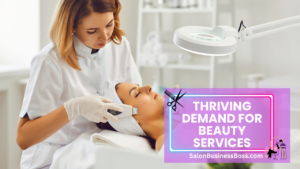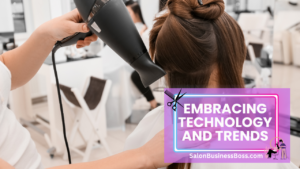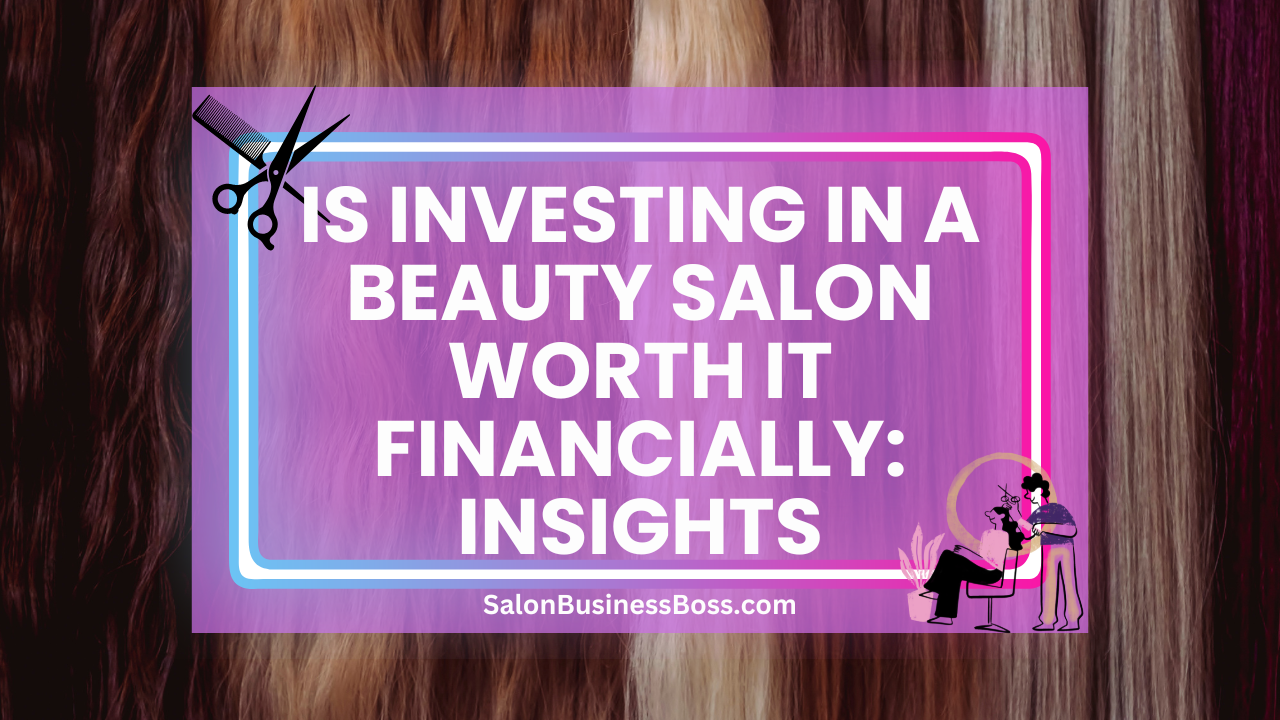Beauty salons have long been an integral part of the cosmetics and personal care industry, catering to the growing demand for beauty and wellness services. These establishments offer a diverse range of treatments and services, including hairstyling, makeup, skincare, nail care, and spa treatments.
Yes, beauty salon is a profitable business. The thriving demand for beauty services, multiple revenue streams, and loyal customer base ensure a consistent stream of clients. By embracing technology, effective cost management, and strategic marketing, salon owners can unlock the full potential of their businesses.
1. Thriving Demand for Beauty Services

The profitability of beauty salons can be attributed to the continuous and escalating demand for beauty services in modern society. In today’s image-conscious world, individuals of all ages are increasingly seeking professional assistance to enhance their appearance and elevate their self-confidence. Whether it’s a fresh haircut, a rejuvenating facial, a stylish manicure, or a relaxing spa treatment, people are willing to invest in their personal grooming and well-being.
The beauty industry has transcended traditional gender boundaries, with men’s grooming and wellness services experiencing significant growth. Men are now more conscious of their appearances, seeking grooming solutions that align with their lifestyles and individual preferences. This expansion of the customer base brings in new opportunities for beauty salons to cater to diverse needs and preferences.
The diverse and expanding customer base provides beauty salons with a steady influx of clients, laying the groundwork for sustainable profitability. The constant flow of customers ensures that there is a consistent revenue stream, reducing the risk of seasonal fluctuations and economic downturns. This stability offers salon owners a sense of financial security and the ability to plan for growth and expansion.
The ever-increasing demand for beauty services in our image-driven society, coupled with the growth of men’s grooming and wellness services, has created a fertile environment for beauty salons to thrive. The industry’s broad and diverse customer base guarantees a continuous stream of clients, making beauty salons a profitable business venture with immense potential for sustained success. As long as the industry continues to evolve and cater to changing consumer preferences, beauty salons are likely to remain at the forefront of the wellness and personal care market.
Read more about: Inside the Beauty Salon Budget: Unveiling Costs
2. Multiple Revenue Streams
The key to maximizing profitability for a successful beauty salon lies in diversifying revenue streams. While offering traditional services like haircuts and facials is essential, the real potential for increased earnings lies in providing add-on services that cater to various customer needs and preferences. Hair extensions and eyelash extensions have gained popularity as they allow clients to achieve their desired looks with ease. Spa treatments, such as massages and body treatments, can elevate the salon’s offerings and attract customers seeking relaxation and rejuvenation.
Retailing beauty products presents another lucrative avenue for revenue generation. By stocking a wide range of hair care items, skincare formulations, makeup products, and other beauty essentials, the salon can tap into the growing demand for at-home beauty solutions. This approach not only boosts sales but also enhances the salon’s reputation as a one-stop-shop for all beauty needs.
Strategically combining service-oriented and retail offerings can mitigate the impact of seasonality on the salon’s revenue. During peak seasons, when clients are more likely to indulge in beauty treatments, the salon can capitalize on its diverse service menu. During slower periods, retail sales can help maintain a steady income flow.
To ensure success, the salon should invest in effective marketing strategies to promote its expanded service and product offerings. Engaging social media campaigns, loyalty programs, and targeted promotions can attract both existing and new clients, encouraging them to explore the salon’s full range of services.
A successful beauty salon should adopt a multi-pronged approach to revenue generation. By diversifying its offerings through add-on services and retail products, the salon can optimize profitability throughout the year and position itself as a comprehensive beauty destination for clients seeking top-notch services and products.
3. Loyalty and Repeat Business
A loyal customer base is a vital asset for any well-established beauty salon, as it plays a pivotal role in driving profitability. Delivering exceptional customer service is the cornerstone of cultivating loyalty among clients. When customers feel valued, heard, and well-cared for, they are more likely to return for future services.
Personalized treatments further enhance the salon experience, as clients appreciate tailored solutions that cater to their specific needs and preferences. Understanding and addressing individual beauty goals fosters a deeper connection between the salon and its clientele, creating a sense of trust and reliability.
Building strong relationships with clients is equally important. Engaging in genuine conversations, remembering personal details, and showing interest in their lives outside the salon demonstrate a commitment to building meaningful connections. These relationships extend beyond a mere transactional exchange, transforming clients into loyal patrons who feel a sense of belonging to the salon community.
A loyal customer base not only ensures repeat business but also becomes a powerful source of word-of-mouth referrals. Satisfied clients who trust and appreciate the salon’s services are more inclined to recommend it to friends, family, and colleagues. Positive word-of-mouth marketing significantly expands the salon’s reach, attracting new customers with little to no marketing expenditure.
Loyal patrons are more likely to explore and avail a wider range of services offered by the salon. As they develop trust in the salon’s expertise, they become more open to trying new treatments, thus increasing their average spend per visit.
Fostering a loyal customer base through exceptional customer service, personalized treatments, and genuine relationship-building is an essential strategy for boosting the profitability of a beauty salon. Satisfied clients not only become loyal patrons, generating consistent revenue, but also act as powerful brand ambassadors, amplifying the salon’s reputation through word-of-mouth referrals. Ultimately, investing in building customer loyalty can lead to sustainable growth and long-term success for the beauty salon.
4. Upselling and Cross-Selling Opportunities
Upselling and cross-selling are effective strategies that beauty salons can leverage to enhance profitability and improve the overall customer experience. When a customer visits the salon for a specific service, such as a haircut, the salon staff can tactfully introduce additional services that complement the customer’s initial choice. For example, while discussing haircut options, the stylist can inquire about the customer’s interest in trying out a hair color treatment or getting a manicure.
By suggesting relevant add-on services during the customer’s visit, the salon enhances the overall experience and provides the customer with a more comprehensive and satisfying beauty experience. This approach not only meets the customer’s immediate needs but also presents them with appealing options they may not have considered initially.
Upselling and cross-selling have significant financial benefits for the salon as well. When customers avail additional services during their visit, it increases the average transaction value, thereby boosting the salon’s revenue. Upselling high-margin treatments or retail products can lead to substantial increases in profits.
To implement upselling and cross-selling successfully, salon staff must be well-trained and knowledgeable about the full range of services offered. They should be able to assess the customer’s preferences and tailor their suggestions accordingly. The key is to make recommendations that genuinely benefit the customer and align with their beauty goals.
However, it’s essential to strike a balance and not be overly pushy or sales-oriented. The focus should always be on providing excellent service and addressing the customer’s needs, rather than solely pursuing financial gains. When executed with sensitivity and care, upselling and cross-selling can create a win-win situation for both the salon and its customers, leading to enhanced profitability and increased customer satisfaction.
5. Embracing Technology and Trends

In today’s fast-paced and ever-evolving beauty industry, staying ahead of technological advancements and embracing the latest beauty trends is imperative for a salon’s profitability. Incorporating modern tools and equipment not only enhances the salon’s capabilities but also attracts tech-savvy customers who seek cutting-edge treatments and services. Advanced hair styling equipment, such as innovative hair dryers and curling irons, can deliver superior results, leaving customers impressed and satisfied.
Laser hair removal machines and state-of-the-art skincare treatments are among the most sought-after beauty services today. By offering these advanced treatments, a salon positions itself as a progressive and forward-thinking establishment, capable of delivering high-quality and effective solutions to its clients.
Embracing popular beauty trends and techniques enables the salon to cater to the ever-changing demands of the market. Whether it’s the latest hair color trends or innovative nail art techniques, staying current with industry trends helps the salon appeal to a broader customer base. The ability to offer trendy and sought-after services not only attracts new clients but also retains existing ones, ensuring a steady stream of business and repeat visits.
Read more about: How to Run a Salon: Ensuring a Relaxing and Luxurious Experience
6. Effective Cost Management
Cost management is a critical aspect of maintaining profitability in the beauty salon business. Controlling expenses related to staff salaries, rent, utilities, and inventory can significantly impact the salon’s bottom line. Implementing smart inventory management practices, such as keeping track of product usage and reordering supplies strategically, can help prevent wastage and reduce costs.
Bulk purchasing is another effective strategy to secure discounts and lower the cost of inventory, resulting in increased profit margins. Negotiating favorable terms with suppliers can further enhance cost efficiency.
Optimizing staff schedules is vital to managing labor costs. By aligning employee work hours with peak customer demand, the salon can ensure it has the right number of staff members at any given time, avoiding unnecessary labor expenses.
Investing in staff training is an investment in service quality and customer satisfaction. Well-trained staff are less likely to make costly mistakes or need costly reworks, leading to improved efficiency and better utilization of resources.
7. Marketing and Branding
An effective marketing strategy is paramount for a beauty salon to thrive in a competitive market. Creating a strong brand identity is the foundation of successful marketing efforts. A well-defined brand identity encompasses the salon’s unique value proposition, mission, and personality, allowing it to stand out in a sea of competitors. Consistent branding across all marketing materials, from the logo to the salon’s interior design, reinforces this identity and makes it memorable to potential customers.
Utilizing social media platforms is an essential component of modern marketing for beauty salons. Platforms like Instagram, Facebook, and Pinterest offer powerful tools for showcasing the salon’s work, highlighting services, and engaging with customers. Eye-catching visuals and before-and-after transformations can captivate audiences and entice them to explore the salon’s services further.
Offering promotions and special deals can also be a compelling way to attract new customers and encourage repeat business. Limited-time discounts, package deals, or loyalty rewards can create a sense of urgency and motivate potential clients to book appointments.
Word-of-mouth marketing is a potent force in the beauty industry. Satisfied customers who have had positive experiences at the salon become brand advocates, sharing their praise and recommendations with friends and family. Encouraging and incentivizing clients to refer others can significantly expand the salon’s customer base without the need for extensive advertising costs.
Combining a well-crafted brand identity, social media presence, enticing promotions, and nurturing word-of-mouth marketing creates a holistic and powerful marketing strategy for beauty salons. By strategically positioning the salon within its target audience’s consciousness, it can attract new clients and foster a loyal community of customers who are eager to share their delightful experiences with others. Ultimately, an effective marketing strategy is the key to expanding the salon’s visibility and securing a firm foothold in the competitive beauty industry.
Conclusion
The beauty salon industry continues to flourish, proving itself as a profitable business venture for aspiring entrepreneurs. With an ever-growing demand for beauty and wellness services, diverse revenue streams, and a loyal customer base, beauty salons have a strong foundation for profitability. By embracing technological advancements, staying abreast of beauty trends, effective cost management, and implementing a robust marketing strategy, salon owners can unlock the full potential of their businesses. However, profitability is not guaranteed, and success in this competitive industry requires dedication, innovation, and a customer-centric approach to stand out in the crowd and build a thriving beauty salon business.
Frequently Asked Questions

1. Is staff training essential for salon profitability?
Yes, well-trained staff improves service quality, reduces rework, and contributes to customer satisfaction, fostering loyalty and profitability.
2. Can I offer package deals to boost profits?
Yes, offering package deals bundling multiple services can entice customers to spend more and increase your salon’s overall revenue.
3. What role does marketing play in salon profitability?
An effective marketing strategy, including social media presence and word-of-mouth marketing, is vital for attracting new clients and building brand recognition.
To learn more on how to start you own salon checkout my startup documents here.
Please note that the contents of this blog are for informational and entertainment purposes only and should not be construed as legal advice. Any action taken based on the information provided in this blog is solely at your own risk. Additionally, all images used in this blog are generated under the CC0 license of Creative Commons, which means they are free to use for any purpose without attribution.

About the author. Entrepreneur and Salon Business Fan.
Hi! I am Shawn and I am a happy individual who happens to be an entrepreneur. I have owned several types of businesses in my life from a coffee shop to an import and export business to an online review business plus a few more and now I create online salon business resources for those interested in starting new ventures. It’s demanding work but I love it. I do it for those passionate about their business and their goals. That’s why when I meet a salon business owner, I see myself. I know how hard the struggle is to retain clients, find good employees and keep the business growing all while trying to stay competitive.
That’s why I created Salon Business Boss: I want to help salon business owners like you build a thriving business that brings you endless joy and supports your ideal lifestyle.

